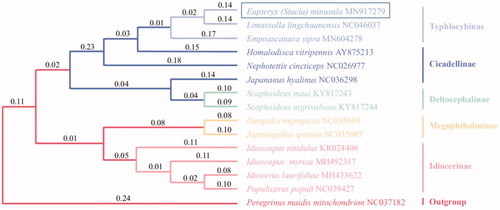Abstract
The complete mitochondrial genome of the leafhopper species Eupteryx (Stacla) minusula (Hemiptera: Cicadellidae: Typhlocybinae) are sequenced and annotated. The mitochondrial genome is 16945 bp, and nucleotide composition of the whole mitogenome is highly A + T biased (A: 43.6%; T: 35.2%, G: 11.3%, C: 9.9%). 11 PCGs have ATN as the start codon, except for atp8 and nad5 genes have TTG. The conventional termination codons (TAA or TAG) occur in 11 PCGs, while cox2 and nad5 uses incomplete codon (T) as termination codon. The complete mitogenome sequence of Eupteryx (Stacla) minusula is available in the GenBank with accession number: MN910279.
The leafhopper genus Eupteryx belongs to the tribe Typhlocybini and distributes in the Palearctic, Nearctic, Oriental and Ethiopian regions (Dworakowska Citation1979). The genus Eupteryx was established by Curtis (Citation1829) with Cicada atropunctaca Goeze as its type species and includes two subgenera Eupteryx and Stacla. And the Eupteryx (Stacla) minusula was reported in 1929 (Lindberg Citation1929). Until now, there are eleven known species of the subgenus Stacla, all restricted to the Oriental Region (Hou et al. Citation2016). In Europe and North America, some species of Eupteryx are important pests of medical and culinary herbs in terms of feeding damage (Henke et al. Citation2013). This genus now contains 120 species, all species are very similar in coloration and difficult to distinguish externally, but the structure of male genitalia are markedly different. A male adult of E. (Stacla) minusula was selected as specimen. All examined samples were collected from Huajiang, Guizhou Province, China. Thetotal DNA was extracted from entire body without abdomen. Phylogenetic analysis was carried out on the basis of 15 available mitogenomes of Hemipteran insects in GenBank including newly sequenced mitogenome of E. (Stacla) minusula with Neighbor-joining (NJ) methods using MEGA ver 6.0. The whole body was preserved in ethanol and deposited in the insect specimen room of Guizhou Normal University with an accession number GZNU-ELS-2019011.
The complete mitochondrial genome of E. (Stacla) minusula is 16,945 bp in size (GenBank accession number: MN910279), contains the set of 37 typical mitochondrial genes (13 protein-coding genes, 22 tRNA genes, and 2 rRNA genes), and an AT-rich region. The nucleotide composition of the whole mitogenome is highly A + T biased(A: 43.6%; T: 35.2%, G: 11.3%, C: 9.9%). All 13 PCGs started with the canonical putative start codon ATN except for the nad5 and atp8 which started with TTG instead. 11 genes shared complete termination codon TAA/TAG, while cox2 and nada used incomplete stop codon (a single T). All tRNA genes are identified by ARWEN version 1.2 software (Laslett and Canback Citation2008). The 16S rRNA gene is 1161 bp long and located between tRNL2 and tRNV; the 12S rRNA gene is 734 bp length and located after tRNV.
The nucleotides sequences of 13 PCGs of E. (Stacla) minusula and other 13 leafhopper species in family Cicadellidae were used to construct phylogenetic tree (). The results showed that E. (Stacla) minusula and other two species of subfamily Typhlocybinae were clustered into one clade, which was separated from other subfamilies. Therefore, the result obtained in this study provided new molecular data for the evolution of the subfamily Typhlocybinae.
Disclosure statement
No potential conflict of interest was reported by the author(s).
Data availability statement
The authors confirm that the data supporting the results of this study can be obtained from the corresponding author, upon reasonable request, or openly available in NCBI GenBank database at (https://www.ncbi.nlm.nih.gov/) with the accession number is MN917279.
Additional information
Funding
References
- Curtis J. 1829. Homoptera. A guide to an arrangement of British insects: being a catalogue of all the named species hitherto discovered in Great Britain and Ireland. London: F. Westley and A. H. Davis. p. 1–256.
- Dworakowska . 1979. On some Typhlocybini (Auchenorrhyncha, Cicadellidae, Typhlocybinae). Bulletin de L’Academie Polonaise Des Sciences Biologique. 26(10):703–713.
- Henke C, Nickel H, Scheu S, Schaeffer I. 2013. Evidence for Wolbachia in leafhoppers of the genus Eupteryx with intersexual morphotypes. B Insectol. 66(1):109–118.
- Hou XJ, Zhang YL, Huang M. 2016. A taxonomic study of the genus Eupteryx curtis (Hemiptera: Cicadellidae: Typhlocybinae), with description of five new records and one new species from China. Zootaxa. 4117(4):591–599.
- Laslett D, Canback B. 2008. ARWEN: a program to detect tRNA genes in metazoan mitochondrial nucleotide sequences. Bioinformatics. 24(2):172–175.
- Lindberg H. 1929. Zur Kenntnis der ostasiatischen Homopteren. Weitere Ergebnisse einer von y. Wuorentaus im Jahre 1917 unternommenen Forschungsreise. Comm Biol. 3(6):1–14.

